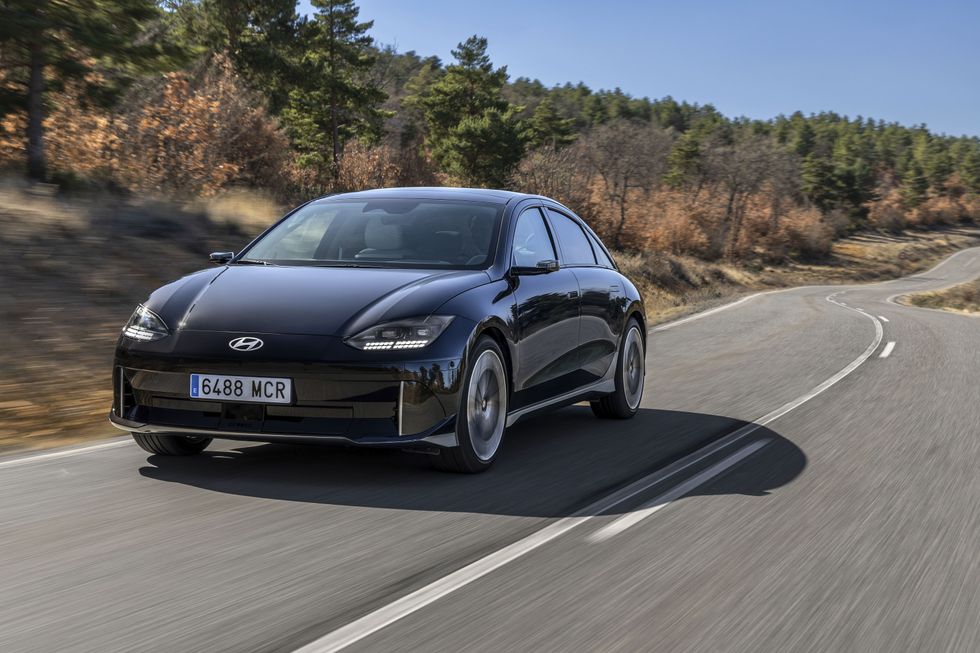Neil Winton is a Senior Contributor for Forbes, writing about the automotive industry in general and EVs in particular. Views expressed are his own. He was formerly European Auto Correspondent for Reuters, wrote the European Perspective column for the Detroit News, and contributed to the Wall Street Journal.
If you’ve just taken delivery of a new electric car, be ready for some nasty surprises. The dealer would have taken you for a test drive, and you would have been very impressed by its luxurious quietness.
You would have ventured onto the motorway and sampled its fabulous performance, more like an Italian supercar than a plain ordinary SUV.
You would have been impressed by the specification. If for example, it was a new Hyundai Ioniq 6, you would be told the range was 384 miles, and the car would sprint to 60mph from rest in under five seconds and on to 115mph. Even though the price was about £55,000, what’s not to like?
It won’t take long though for some nasty surprises to emerge. The deal probably included a home charger and after a couple of days you will plug it in. Here‘s where the infatuation starts to crumble. You left the car charging overnight for the cheapest rate of electricity and you look at the range available next day when “fully charged”. It says 270 miles, not 384 miles. Where did the other 114 miles go you will ask?
Do you have a story you’d like to share? Get in touch by emailingmotoring@gbnews.uk
The 2023 Honda e:Ny1
HONDA
Slightly Downhill, Following Wind
The answer won’t amuse you. The dealer will have mumbled something about official figures and WLTP. This stands for Worldwide Harmonised Light Vehicle Test Procedure. All EVs sold in Europe are rated by WLTPare rated by WLTP despite the fact this theoretical computer data never gets close to real-world outcomes. Cynics might say WLTP is the acronym for Slightly Downhill, Following Wind (SDFW) in some obscure European language.
Then you set off for a business appointment. It’s 300 miles away up the motorway. You settle down for the long-distance cruise at an indicated 80mph, just like the rest of the traffic. After an hour you glance at the range remaining indicator, and it’s already taken 120 miles. That’s because this car at motorway speeds loses nearly 40 per cent of the promised range. If you start with 100 miles, at these speeds it will get you about 60 miles. That’s because of the physics of electric cars versus diesels. At high revolutions and high but legal speeds the electric motor strains to produce the extra power. At these speeds a torquey diesel will have settled into a relaxed and powerful low-revving gait.
Peter Wells, Professor of Business and Sustainability at Cardiff Business School has put it this way.
Range Falls Of A Cliff
“Range falls off a cliff at high speed. For an electric car, the extra energy required getting from 60mph to 75mph is astonishing and virtually doubles energy consumption to move all that air out of the way,” Wells said.
It’s not just the Ioniq 6. This scenario is typical across all EVs. You’ve probably heard the radio ads for the new Honda e:Ny1, which claims a range of 256 miles, but in reality averaged about 162 miles per charge for me. Its motorway performance was a little better with only a 27 per cent penalty to the promised high-speed range, but that translates into a motorway range of only 118 miles.
You’ll be aware of the threat from new Chinese EVs. They are very impressive technically with high quality and competitive prices. But on the highway they are the worst performers, with the Polestar 2 (made by Geely of China) trashing 59 per cent of the promised range, the BYD ATTO 3 61 per cent and the BYD Seal 66 per cent.

The 2023 Hyundai Ioniq 6
HYUNDAI
Excluding Tesla
There is one notable standout and that’s Tesla. The Model 3 and Model Y offer battery capacity of 360 miles and 331 miles respectively, and after charging they will give you just about exactly that. But on the highway the same EV vs ICE rules apply and the Model 3 has a 30 per cent penalty and the Model Y 45 per cent. The latter is an SUV and has a much higher profile adding to wind resistance.
How come this is probably news to you? After all, the media regularly writes reviews of these vehicles. Why haven’t they informed the public? Automakers provide bare-bones statistics, and the car launch process doesn’t make it easy for the media to examine the data in detail. Range is often described as “up to” a large number. Some reviews though are written after reporters borrow the cars for a week. There is no excuse for this process failing to reveal more details, but most reporters probably don’t have home chargers. Battery and range details don’t get tested.
The automakers’ range claims don’t make clear the data was generated at an average speed of probably 55mph. There is never any hint that fast motorway cruising will devastate range. There is never any hint that when you recharge the battery it might never get close to the WLTP claim.
LATEST DEVELOPMENTS:

Neil Winton is a Senior Contributor for Forbes, writing about the automotive industry in general and EVs in particular
SUPPLIED
Step Up To The Plate
The carmakers need to step up to the plate.
Manufacturers should make clear the range claim is based on an average 55mph, the fast lane cruising penalty is (say) 50 per cent, and the battery will often not even get close to WLTP.
Happy EV motoring.

